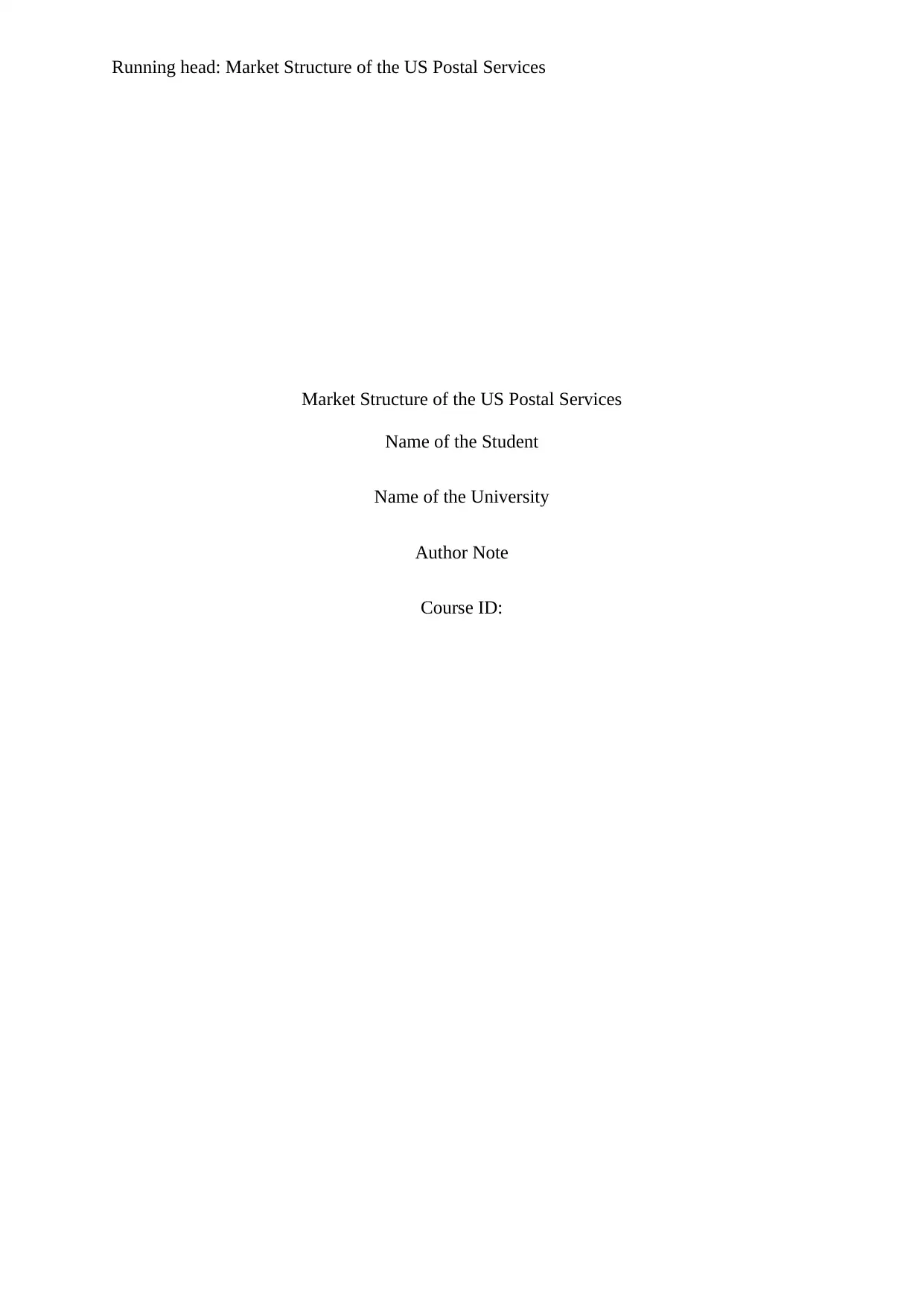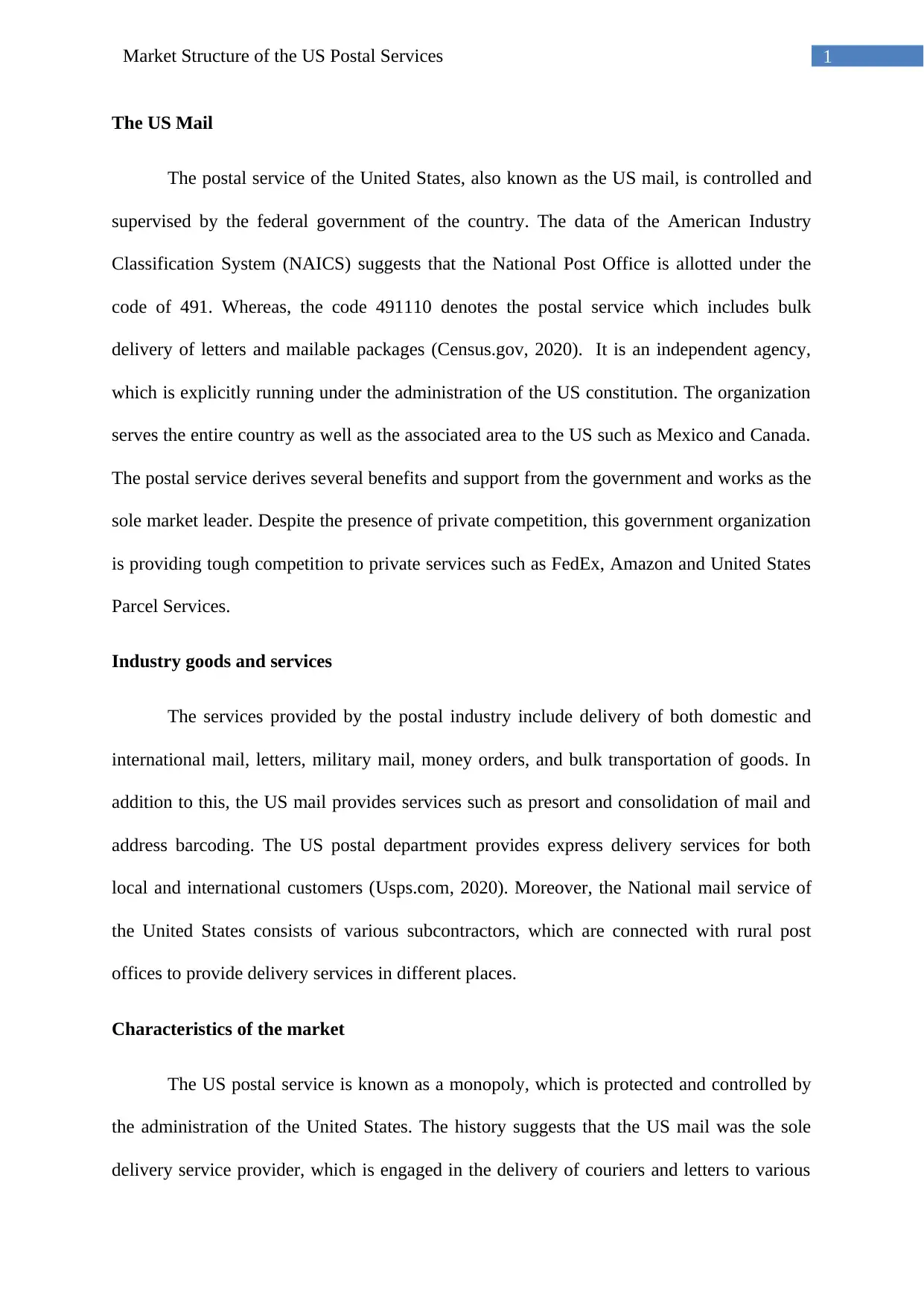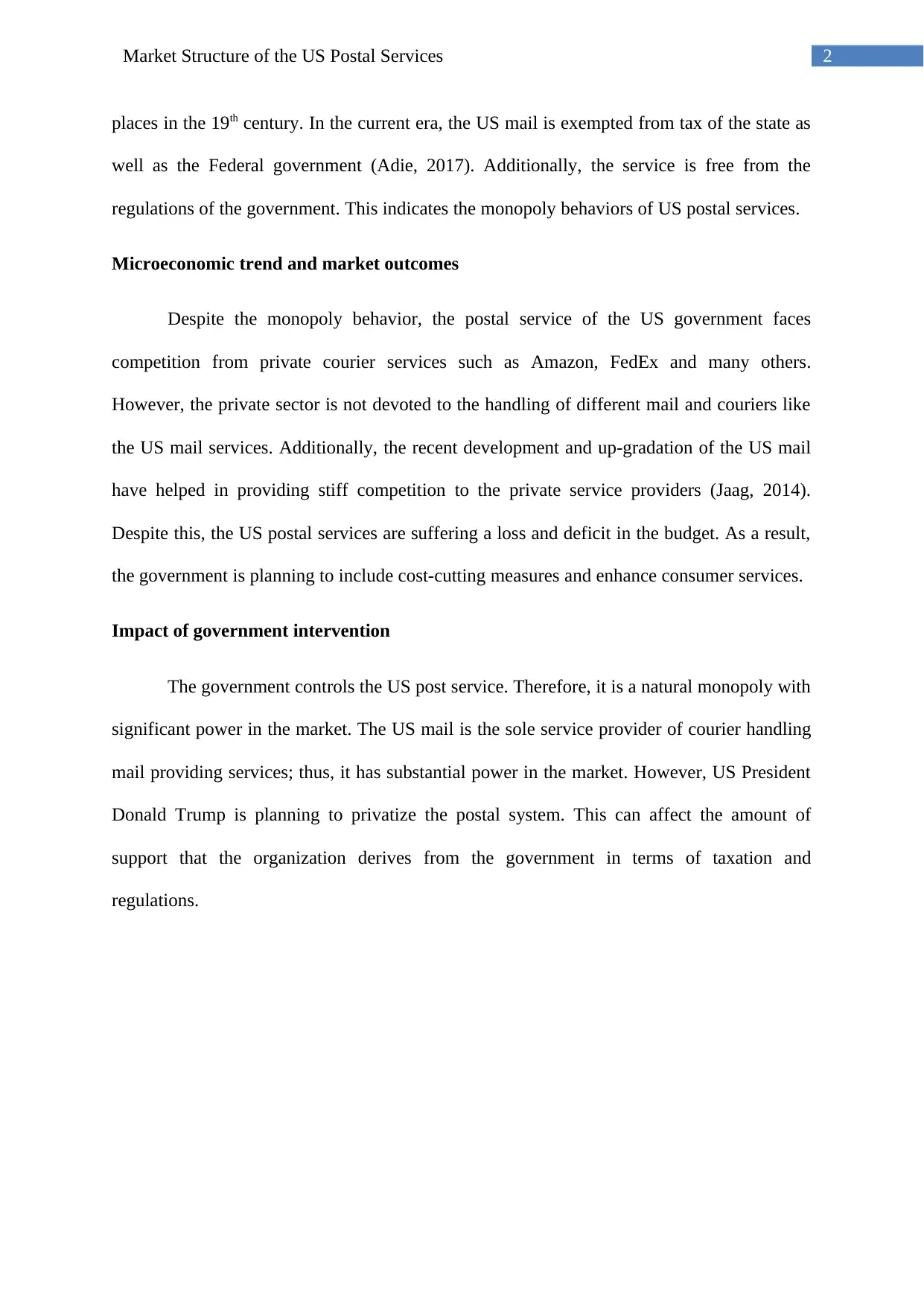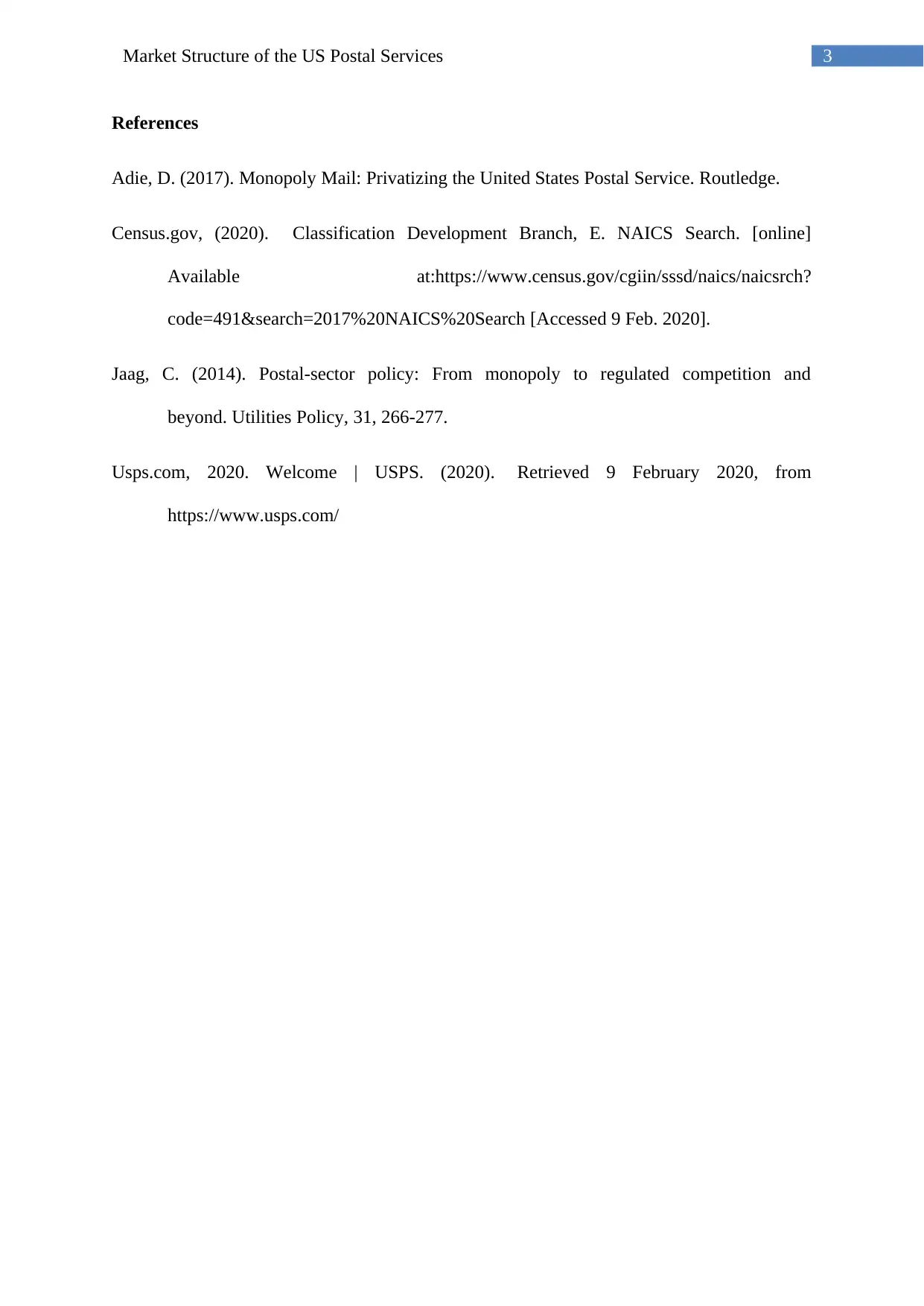Market Structure of the US Postal Services
VerifiedAdded on 2022/08/15
|4
|731
|21
AI Summary
Contribute Materials
Your contribution can guide someone’s learning journey. Share your
documents today.

Running head: Market Structure of the US Postal Services
Market Structure of the US Postal Services
Name of the Student
Name of the University
Author Note
Course ID:
Market Structure of the US Postal Services
Name of the Student
Name of the University
Author Note
Course ID:
Secure Best Marks with AI Grader
Need help grading? Try our AI Grader for instant feedback on your assignments.

1Market Structure of the US Postal Services
The US Mail
The postal service of the United States, also known as the US mail, is controlled and
supervised by the federal government of the country. The data of the American Industry
Classification System (NAICS) suggests that the National Post Office is allotted under the
code of 491. Whereas, the code 491110 denotes the postal service which includes bulk
delivery of letters and mailable packages (Census.gov, 2020). It is an independent agency,
which is explicitly running under the administration of the US constitution. The organization
serves the entire country as well as the associated area to the US such as Mexico and Canada.
The postal service derives several benefits and support from the government and works as the
sole market leader. Despite the presence of private competition, this government organization
is providing tough competition to private services such as FedEx, Amazon and United States
Parcel Services.
Industry goods and services
The services provided by the postal industry include delivery of both domestic and
international mail, letters, military mail, money orders, and bulk transportation of goods. In
addition to this, the US mail provides services such as presort and consolidation of mail and
address barcoding. The US postal department provides express delivery services for both
local and international customers (Usps.com, 2020). Moreover, the National mail service of
the United States consists of various subcontractors, which are connected with rural post
offices to provide delivery services in different places.
Characteristics of the market
The US postal service is known as a monopoly, which is protected and controlled by
the administration of the United States. The history suggests that the US mail was the sole
delivery service provider, which is engaged in the delivery of couriers and letters to various
The US Mail
The postal service of the United States, also known as the US mail, is controlled and
supervised by the federal government of the country. The data of the American Industry
Classification System (NAICS) suggests that the National Post Office is allotted under the
code of 491. Whereas, the code 491110 denotes the postal service which includes bulk
delivery of letters and mailable packages (Census.gov, 2020). It is an independent agency,
which is explicitly running under the administration of the US constitution. The organization
serves the entire country as well as the associated area to the US such as Mexico and Canada.
The postal service derives several benefits and support from the government and works as the
sole market leader. Despite the presence of private competition, this government organization
is providing tough competition to private services such as FedEx, Amazon and United States
Parcel Services.
Industry goods and services
The services provided by the postal industry include delivery of both domestic and
international mail, letters, military mail, money orders, and bulk transportation of goods. In
addition to this, the US mail provides services such as presort and consolidation of mail and
address barcoding. The US postal department provides express delivery services for both
local and international customers (Usps.com, 2020). Moreover, the National mail service of
the United States consists of various subcontractors, which are connected with rural post
offices to provide delivery services in different places.
Characteristics of the market
The US postal service is known as a monopoly, which is protected and controlled by
the administration of the United States. The history suggests that the US mail was the sole
delivery service provider, which is engaged in the delivery of couriers and letters to various

2Market Structure of the US Postal Services
places in the 19th century. In the current era, the US mail is exempted from tax of the state as
well as the Federal government (Adie, 2017). Additionally, the service is free from the
regulations of the government. This indicates the monopoly behaviors of US postal services.
Microeconomic trend and market outcomes
Despite the monopoly behavior, the postal service of the US government faces
competition from private courier services such as Amazon, FedEx and many others.
However, the private sector is not devoted to the handling of different mail and couriers like
the US mail services. Additionally, the recent development and up-gradation of the US mail
have helped in providing stiff competition to the private service providers (Jaag, 2014).
Despite this, the US postal services are suffering a loss and deficit in the budget. As a result,
the government is planning to include cost-cutting measures and enhance consumer services.
Impact of government intervention
The government controls the US post service. Therefore, it is a natural monopoly with
significant power in the market. The US mail is the sole service provider of courier handling
mail providing services; thus, it has substantial power in the market. However, US President
Donald Trump is planning to privatize the postal system. This can affect the amount of
support that the organization derives from the government in terms of taxation and
regulations.
places in the 19th century. In the current era, the US mail is exempted from tax of the state as
well as the Federal government (Adie, 2017). Additionally, the service is free from the
regulations of the government. This indicates the monopoly behaviors of US postal services.
Microeconomic trend and market outcomes
Despite the monopoly behavior, the postal service of the US government faces
competition from private courier services such as Amazon, FedEx and many others.
However, the private sector is not devoted to the handling of different mail and couriers like
the US mail services. Additionally, the recent development and up-gradation of the US mail
have helped in providing stiff competition to the private service providers (Jaag, 2014).
Despite this, the US postal services are suffering a loss and deficit in the budget. As a result,
the government is planning to include cost-cutting measures and enhance consumer services.
Impact of government intervention
The government controls the US post service. Therefore, it is a natural monopoly with
significant power in the market. The US mail is the sole service provider of courier handling
mail providing services; thus, it has substantial power in the market. However, US President
Donald Trump is planning to privatize the postal system. This can affect the amount of
support that the organization derives from the government in terms of taxation and
regulations.

3Market Structure of the US Postal Services
References
Adie, D. (2017). Monopoly Mail: Privatizing the United States Postal Service. Routledge.
Census.gov, (2020). Classification Development Branch, E. NAICS Search. [online]
Available at:https://www.census.gov/cgiin/sssd/naics/naicsrch?
code=491&search=2017%20NAICS%20Search [Accessed 9 Feb. 2020].
Jaag, C. (2014). Postal-sector policy: From monopoly to regulated competition and
beyond. Utilities Policy, 31, 266-277.
Usps.com, 2020. Welcome | USPS. (2020). Retrieved 9 February 2020, from
https://www.usps.com/
References
Adie, D. (2017). Monopoly Mail: Privatizing the United States Postal Service. Routledge.
Census.gov, (2020). Classification Development Branch, E. NAICS Search. [online]
Available at:https://www.census.gov/cgiin/sssd/naics/naicsrch?
code=491&search=2017%20NAICS%20Search [Accessed 9 Feb. 2020].
Jaag, C. (2014). Postal-sector policy: From monopoly to regulated competition and
beyond. Utilities Policy, 31, 266-277.
Usps.com, 2020. Welcome | USPS. (2020). Retrieved 9 February 2020, from
https://www.usps.com/
1 out of 4
Related Documents
Your All-in-One AI-Powered Toolkit for Academic Success.
+13062052269
info@desklib.com
Available 24*7 on WhatsApp / Email
![[object Object]](/_next/static/media/star-bottom.7253800d.svg)
Unlock your academic potential
© 2024 | Zucol Services PVT LTD | All rights reserved.





